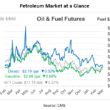UK newspapers hardly resemble the US market. The old Fleet Street national brands still dominate UK dailies and even the most historic regional newspapers are disintegrating faster than anyone could have guessed. Who would have predicted that The Scotsman, which was selling more than 100k copies in 2000, would shrink to a mere 12k in 2020? Or that the Yorkshire Post would crash from 76k to 17k, or the Manchester Evening News from 150k to just 18k?
By contrast, one symptom of the more promising prospects for regional news in the US has been growing private equity ownership, culminating in the recent $1.4bn acquisition of Gannett by its nearest competitor. For all the differences, UK newspapers are feeling the heat of the US market.
Last week, Gannett announced it had paid down $36.2m of its debt, saying that “reducing our leverage is a high priority”. While the payment was a small reduction in the company’s $1.8bn debt, it was a sign that Gannett will do everything it can to rid itself of the borrowings used to create the largest US newspaper publisher. Across the Atlantic, it is assumed that will eventually include Gannett’s sale of Newsquest, the UK’s highly-profitable second largest regional publisher.
In the UK, it is believed that even the slight prospect of being able to buy the £200m-revenue/ £35m EBITDA Newsquest may be delaying the deal to acquire JPI Media (the bankrupt former Johnston Press) by veteran newspaper entrepreneur David Montgomery’s National World. Perhaps he wants to buy both companies. But, whereas the price for the battered JPI will be less than £50m, Montgomery might need to raise some £150m in order to acquire Newsquest, which may be the only UK regional publisher that could attract bids from private equity.
The trouble is that seeking to acquire both companies together (if National World could do it) would almost certainly be referred to the Competitions & Market Authority (CMA). That probability seems to have increased with the disclosure that the government is “minded” to refer the Daily Mail’s £50m acquisition of JPI’s i national tabloid. A decision is expected next week.
The government-supporting Daily Mail will be especially disconcerted by any referral to the CMA, given i’s mere 170k national paid circulation and the fact that the DMGT parent is a smaller UK news publisher than either News Corp or Reach Plc (the former Trinity Mirror). Gannett may actually be calculating that Newsquest will achieve a higher price once the JPI deal is out of the way.
Meanwhile, there is speculation about the future direction of Reach (the UK’s largest newspaper group) whose own agreed 2019 bid to acquire JPI was discarded by its new CEO Jim Mullen. Next month, he will present to investors an “update on the strategic plans for long-term value creation”. It is assumed they will include accelerated digitalisation, especially of its hyper-local services, and possible closures or disposals of some newspapers. We wonder also whether Reach will seek some kind of transformative news partnership with existing digital or broadcast companies.
But three things have happened since.
First, it has become clear that there are a large number of would-be acquirers of the Telegraph including publishers in Europe and the US, and sovereign wealth funds from the Middle East and Asia. At least one company has made a direct approach to the Telegraph’s owners in recent weeks.
Second, advisers realise (especially after acquisition of the i newspaper) that any DMGT bid would be hampered by an almost inevitable and lengthy competitions referral. That risk would inevitably favour bids from companies and individuals without existing UK media assets. Ironically, would-be bidders have responded to DMGT’s potential synergies by exploring their own scope to share perhaps everything except content and “ownership” with existing publishers. After all, the Telegraph’s printing and distribution is already handled by arch-rival News Corp with which it also shares industry-wide digital advertising sales. You can sense the way that the UK’s age-old ownership restrictions may be accommodated by ever closer collaboration and cost-sharing between rival newspapers.
Third, the likely price is now thought to be substantially higher than the initial speculation. It is believed that Telegraph Media Group might attract bids of £300-400m. That could be 12x the EBITDA from 2016, perhaps not too high for a trophy asset with prospects, and whose revenue has slipped only 9% in the two years since. But the valuation has been stoked, more than anything else, by developments from across the Atlantic.
This week, the New York Times (NYT) continued to re-write the future for (at least some) daily newspapers by disclosing that it has exceeded its target of $800m of digital revenue a full year ahead of schedule. Back in 2015, when digital revenue was around $400m, the NYT had said it would double the total by the end of 2020. In 2019, it actually added more than 1m digital subs net – the highest level since it launched the digital model in 2011. It now has more than 5m digital subscriptions.
The real story continues to be that “only” 3.4m are core news subscriptions. Like quality news brands everywhere, the NYT has benefitted in an era of mistrusted politicians and fake online news, reflected in the digital scores and also in 900k print subscribers. But the headlines belong to the soaring success of niche digital products. The NYT daily Crossword now has 600k subscribers, and a further 300k pay for the NYT Cooking Platform. It has also launched a Parenting platform.
CEO-president Mark Thompson says the NYT is “on track” to hit 10m total subs by 2025, with 2m from outside the US (500k currently). That success, especially as a burgeoning global news brand, is being quoted by would-be bidders for the Telegraph as an example of what could be achieved in the UK. Even at this stage, there are some encouraging signs.
Last month, the Telegraph reported a total of 420k paying subscribers, an increase of some 24% in 2019 which (with digital offsetting the decline in print) has produced a claimed 10% increase in subs revenue. The subscribers are some 8% of the news brand’s 5m (non-paying) registered users who get access to some of the paywall content. A digital subscription costs £2 per week, or (curiously) £3 including the newspaper’s digital edition. A seven-day print subscription costs £11.50. In 2018, Telegraph CEO Nick Hugh (ex Yahoo) set a target of reaching 10m registered users and 1m paid subscribers by 2023.
Offsetting the good news were the print circulation figures for December 2019 which show the Daily Telegraph averaged 317k and the Sunday Telegraph 248k – both 12% behind the previous year.
In a relatively low-impact response to the launch of Premier League Football content by The Athletic, the Telegraph has been offering a digital subscription for just its sports content at £1 per week. Take-up has been modest but it’s a start to recognising (as the New York Times did years ago) that newspaper companies must rethink the traditional newspaper ‘package’, especially if they are to attract younger digital audiences.
Private equity firms eyeing Telegraph Media Group are poring over the lessons from New York (one even suggested seeking formal collaboration with the NYT). They are appetized by the growing international digital audiences already enjoyed by quality UK news brands including the digital-only The Independent.
But their primary focus may be those NYT’s niche digital subscriptions. You would think that The Telegraph (and, come to that, News Corp UK’s The Times) could readily emulate the success with Crosswords. They might also operate “verticals” in Politics, Travel, Business, Personal Finance as well as Football and other sports.
The crucial issues in assessing the viability of such “verticals” would include the extent to which they were able to include exclusive content additional to the regular news brand. And, of course, the price. NYT has frequently referred to the Crossword app as a lead-in for subscriptions to the core product. However, such digital products could clearly be viewed as independent specialist media “channels” that could be augmented by brands and content from existing magazines, digital media and broadcasts. In time, they could compete with the specialist media of Discovery.
In a world where the internet increasingly serves specialist global audiences, such “verticals” could transform the longterm prospects of news brands with data products, digital streaming, and e-commerce.
That’s how these famous newspaper-centric brands can use their still-powerful platforms to create a runway to the future. But hurry.




